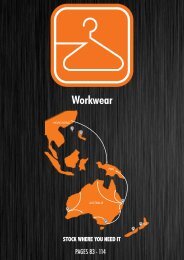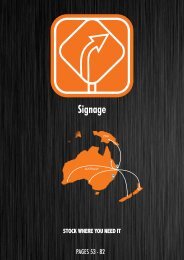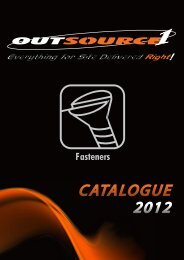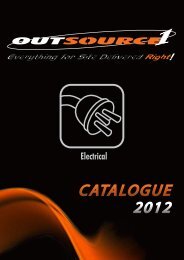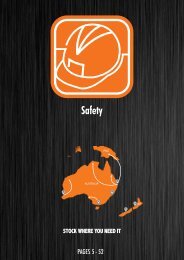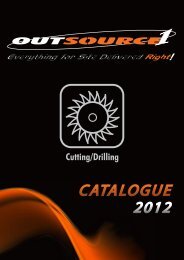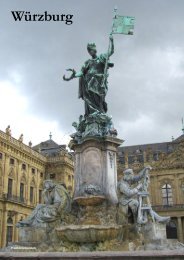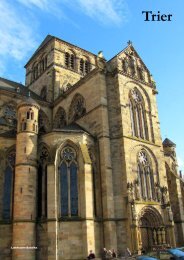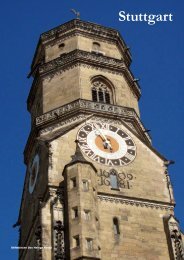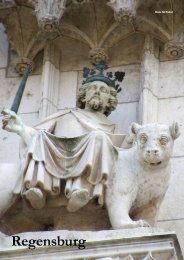Raven Guides: Germany - Passau
You also want an ePaper? Increase the reach of your titles
YUMPU automatically turns print PDFs into web optimized ePapers that Google loves.
The late Baroque and Neoclassical bishops’<br />
residence Neue Residenz at Residenzplatz has<br />
an ornate staircase with stucco decoration putting<br />
it among <strong>Germany</strong>’s finest (along with a ceiling<br />
fresco) usually accessible through the west door.<br />
The adjacent cathedral treasury can be reached<br />
through the cathedral. Outside on Residenzplatz<br />
is the Wittelsbacher Brunn, after the Baroque<br />
style but actually early 20th century. The<br />
Neoclassical Fürstbischöfliche Opernhaus<br />
building at the west end now houses the<br />
Stadttheater.<br />
The Rathaus goes back to at least the 14th century,<br />
although the present tower is Neogothic. The vaulted great<br />
assembly hall Großer Rathaussaal and small hall were<br />
stuccoed by Carlone in the 17th century after the great fire.<br />
In the 19th century local artist Ferdinand Wagner painted<br />
the ceilings with events from local history and<br />
Nibelung motifs when the other Wagner was in high vogue.<br />
The Rathausplatz facade with the Danube’s historical flood<br />
markers indicates the many deluges the city has survived.<br />
Großer Rathaussaal (late March-Oct M-Su 10-16, late<br />
Nov-early Jan M-Su 10-16, €2/1.50) is also part of the city<br />
tour but it or the smaller hall are often closed for functions.<br />
The tower glockenspiel sounds daily at 10.30, 14.00 and<br />
19.25 with an extra Saturday carillion at 15.30.<br />
The Dom St Stephan at Domplatz is a Gothic cathedral<br />
transformed after a 17th century fire to Italian Baroque<br />
on a grand scale by the innovative plans of Prague<br />
resident Carlo Lurago and the Italian architect Paolo<br />
d’Aglio. The opulent stucco work is by Giovanni<br />
Battista Carlone and frescoes by Carpoforo Tencalla<br />
feature the stoning of the saint. It houses one of the<br />
world’s great church organs of almost 18,000 pipes.<br />
Half-hour organ concerts (May-Oct or Christmas-New<br />
Year’s Eve, M-Sa 12-12.30, holidays closed, €4/2<br />
children under 10 free) are a highlight but connoisseurs<br />
might prefer the one-hour evening performances (May-<br />
Oct Th 19.30-20.30, €8/5).<br />
Kloster Niedernburg’s Klosterkirche zum Heiligen<br />
Kreuz in Jesuitengasse is the resting place of the blessed<br />
Gisela, queen of St Stephen and daughter of the Bavarian<br />
duke Heinrich II. The largely 12th century Romanesque<br />
church is on the site of a Carolingian predecessor. Gisela<br />
entered the convent after her husband’s death and was<br />
abbess when she died in the 1060s. Most of her remains<br />
(bones of the couple were reunited in Hungary in 1996) lie<br />
on the south side of the church, now a pilgrimage site. The<br />
Benedictine foundation was the centre of the <strong>Passau</strong><br />
bishops when they were styled prince-bishops early in the<br />
13th century and it is speculated that the Niebelungenlied<br />
poet had a special relationship with it. It was later taken<br />
over by the sisterhood founded by English nun Mary Ward.<br />
Veste Oberhaus, the Gothic castle high above the Danube,<br />
overlooking the old town, is the former fortress of the<br />
<strong>Passau</strong> bishops and later a military prison. Apart from the<br />
spectacular view and youth hostel there is the excellent<br />
Oberhausmuseum <strong>Passau</strong> (see Museums below), pulling<br />
together the themes of the city’s complex history. Walking<br />
up (the path Ludwigsteig closes at 17.00 daily) involves a<br />
little effort and many will find the half-hourly shuttle bus<br />
from Rathausplatz (mid Apr-early Nov M-F 10-17, Sa-Su<br />
10-18, €1.70/€1.20, families €5.50) worth the fare and opt<br />
for the stroll down. At times the path becomes hazardous<br />
during winter weather. Veste Niederhaus below, though<br />
connected by battlements, is closed to the public and the<br />
best view of it is from a river ferry or Dreiflüsse Eck.<br />
Omnibusbahnhof on Dr-Hans-Kapfinger-<br />
Straße at Nibelungplatz handles regional and<br />
long-distance buses.<br />
Danube ferries (see Cruises) are the<br />
leisurely alternatives in both directions.<br />
Bicycle riders find in <strong>Passau</strong> the hub of<br />
several bicycle paths. The German portion of<br />
the Donauradweg from Donaueschingen joins<br />
the Austrian portion at the border, continuing<br />
via Linz to Vienna. The Inntalradweg follows<br />
the Inn valley to Innsbruck in Austria,<br />
continuing to the pass at Maloja beyond St<br />
Moritz in Switzerland.<br />
Other routes lead to Salzburg, Neumarkt in<br />
der Oberpfalz and Bad Gögging on the Danube<br />
between Regensburg and Ingolstadt (called the<br />
Via Danubia or Römerradweg).<br />
City transit: Local buses also converge on<br />
the ZOB. The VBP local transit information<br />
office there (see Quick Guide) is open to 18.00<br />
on the first two and last two working days of<br />
each month.<br />
<strong>Passau</strong> has extensive pedestrian zones and<br />
the only buses likely to appeal (unless crossing<br />
the Inn) are the castle shuttle and Citybus. The<br />
VBP bus network, including the shuttle, is<br />
covered by <strong>Passau</strong>Card (see below) or Bayern-<br />
Ticket. Single-trip tickets (€1.70/1.20) last 90<br />
minutes and allow changes of bus (except for<br />
the castle shuttle) but strip tickets for eight<br />
journeys (€9/5.50, to be validated on board)<br />
are considerably cheaper. Tickets can be<br />
bought from bus drivers.<br />
The Citybus (M-Sa 7.30-18.30, single trip<br />
€0.90) shuttles between the Hauptbahnhof<br />
and Römerplatz at the end of Prinzregent-<br />
Leopold-Brücke via Rathausplatz and the<br />
ZOB. Motorists with a short-term parking pass<br />
at the Hauptbahnhof Parkhaus can use this as<br />
a Citybus ticket.<br />
Bus route numbers preceded by a K are<br />
for smaller vehicles. A contracted evening bus<br />
service (M-Su 20.30-23.30) runs nine routes<br />
from the ZOB to connect outer areas.<br />
There are several bike hire options.<br />
Fahrrad-Laden <strong>Passau</strong> (tel 0851-72226, Apr-<br />
Sep M-F 8-18, Sa 8-14, Oct-Mar M-F 10-18,<br />
Sa 10-14) at Roßtränke 12 has bicycles at €13<br />
per day, €11 per day for three days and €10 per<br />
day for a week and can arrange access to public<br />
bike lockers for travellers. Bikehaus (tel 0151-<br />
12834224, Mar-mid Oct M-Su 9-12.30, 15-18)<br />
at the end of platform 1 at the Hauptbahnhof<br />
has similar rates and is part of the Rent A<br />
Bike network, offering a pick-up and drop-off<br />
scheme along the Danube to Vienna.<br />
<strong>Passau</strong>Card<br />
The card allows free entry to <strong>Passau</strong> museums,<br />
free city tours and three rivers cruises (see<br />
Cruises), a return trip on the castle shuttle<br />
bus (and a coffee at the cafe) and free bus<br />
travel. Discounts or specials on shopping and<br />
attractions in the <strong>Passau</strong> region are included.<br />
<strong>Passau</strong>Cards for one, two or three days<br />
(€15/12, €22/15 or €27.50/19) or up to<br />
three weeks (€59/41) are available at tourist<br />
information offices and many accommodation<br />
houses.<br />
Tours<br />
English city sightseeing tours are by<br />
arrangement only (tel 0851-955980, email<br />
stadtfuehrung@passau.de). But electronic<br />
guides in English can be hired (€7.50 for<br />
three hours, €10 overnight for return the next<br />
<strong>Passau</strong> 2 - RAVEN TRAVEL GUIDES GERMANY






